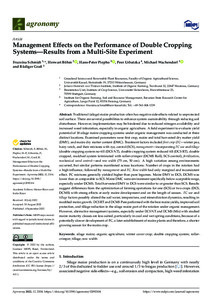| dcterms.abstract | Traditional (silage) maize production often has negative side-effects related to unprotected soil surface. There are several possibilities to enhance system sustainability through reducing soil disturbance. However, implementation may be hindered due to reduced nitrogen availability and increased weed infestation, especially in organic agriculture. A field experiment to evaluate yield potential of 18 silage maize cropping systems under organic management was conducted at three distinct locations. Examined parameters were first crop, maize and total harvested dry matter yield (DMY), and maize dry matter content (DMC). Treatment factors included first crop (FC—winter pea, hairy vetch, and their mixtures with rye, control (SCS), management—incorporating FC use and tillage (double cropping system no-till (DCS NT), double cropping system reduced till (DCS RT), double cropped, mulched system terminated with roller-crimper (DCMS Roll), SCS control), fertilization, mechanical weed control—and row width (75 cm, 50 cm). A high variation among environments occurred, but similar patterns manifested across locations: Number of crops in the rotation had a high influence, followed by management and FC. Row width had only marginal and inconsistent effect. FC mixtures generally yielded higher than pure legumes. Maize DMY in DCS, DCMS was lower than or comparable to SCS. Maize DMC were environment-specifically below acceptable range, especially under DCMS. Total harvested DMY in DCS were similar to or greater than SCS. Results suggest differences from the optimization of farming operations for one (SCS) or two crops (DCS, DCMS) with strong effects at early maize development and on the length of season. FC use and tillage factors possibly altered the soil water, temperature, and mineralization dynamics, resulting in modified maize growth. DCS RT and DCMS Pure performed with the best maize yields, improved soil protection, and tillage reduction in the silage maize part of the rotation under organic management. However, alternative management systems, especially under DCS NT and DCMS (Mix) with studied maize maturity classes are less suited, particularly in cool and wet spring conditions, because of a potentially slower development of FC, a later establishment of maize plants and therefore, a shorter growing season for the maize crop. | eng |


